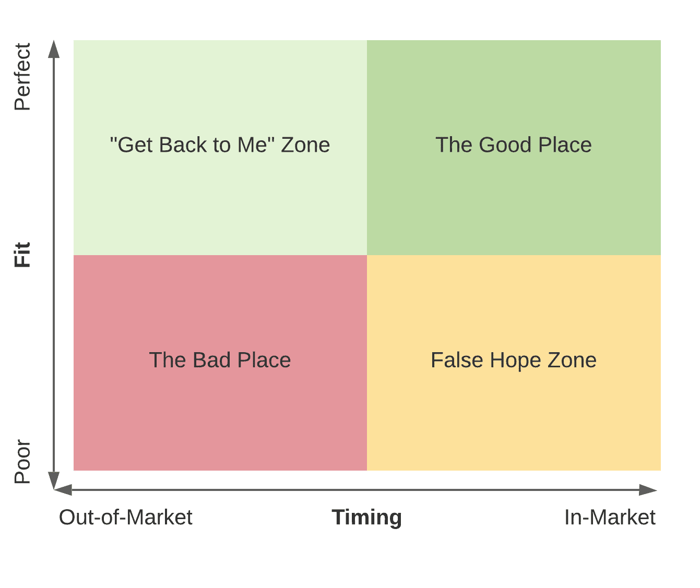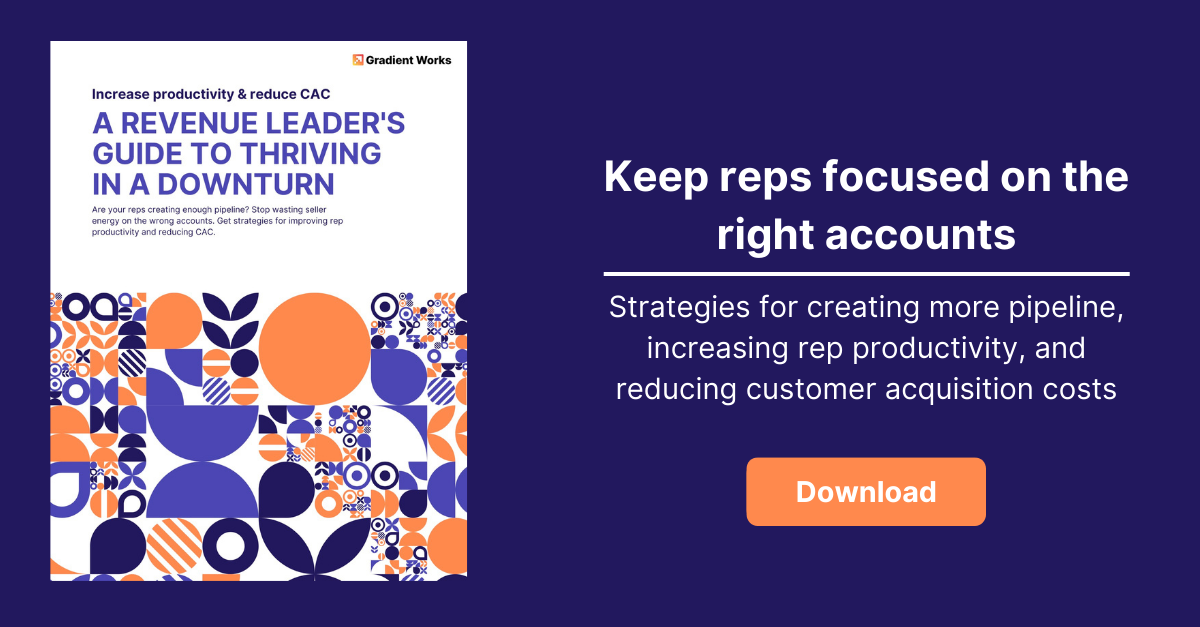Sales management is about making sure the right rep takes the right action with the right account at the right time. A big part of that comes down to a combination of fit and timing.
The relationship between fit and timing
We all want to increase rep productivity and attainment. And while there are a hundred different levers can you pull to attempt to increase attainment, better managing rep books is a good place to start. It's all about finding the right accounts to work, and then working them at the right time.
Most companies have a fit definition (“this kind of account is a fit for our solution”), and they try to figure out the right timing (“when should we reach out for maximum impact?”).
Fit. Does the account fit your ideal customer profile? What are the firmographics of the organization, and how close are they to what you consider a good customer?
Timing. Even the perfect accounts may not be ready to buy. There are internal and external signals you can identify that tell you how likely an organization is to buy now. Accounts are either ready and in market for a solution like yours (they don’t currently have a vendor for the problem you solve or their contract is almost up, they have budget, something’s changing in their company that you can help with) or they’re not (they just signed with another vendor, they’ve had to cut costs, organizational change isn’t pointed in your direction).
Here, we’re going to talk about fit and timing for SDRs and BDRs. But first, let's talk about the fit and timing quadrant (also known as the FT Quadrant).
 The Good Place. These accounts are both a great fit and they’re ready to buy. These are the opportunities you can win in the short term and ideally where your reps are spending most of their time. This is the zone to win.
The Good Place. These accounts are both a great fit and they’re ready to buy. These are the opportunities you can win in the short term and ideally where your reps are spending most of their time. This is the zone to win.
Get Back to Me (GBTM) Zone. These accounts are a great fit but the timing isn’t right (yet). They may be under contract with a different vendor or have another major priority this quarter. When you talk to them, they’ll probably say something like “This sounds great, but let’s talk next quarter.” This is valuable information you can use later, and you should absolutely be keeping track of that. More on that in a bit.
False Hope Zone. These accounts are a bad fit even though they’re currently looking for a solution. In fact, you’ll probably even win some of these - mostly because they’re ready to buy something similar to what you offer. But, you’re likely to find that you can’t repeat this process, and/or they’re bad customers who will be difficult to service and likely to churn. These will often come through your inbound demand gen channel and are tricky because reps will hear only the good news about timing and ignore the bad fit signals.
The Bad Place. These accounts aren’t a fit and they’re not looking to buy. Hopefully, you’ll avoid these altogether, but it’s more likely that your team will waste time on a sales cycle with no chance of success. These frequently arise from poor prospecting. If you have a geographic territory model, reps are in danger of spending a lot of time here unless they’re excellent at discovery and qualification.
Accounts can move between quadrants, though your ability to influence that movement is limited.
Timing signals change predictably over time. Accounts will move back and forth between being in market and not in market as they buy solutions, renew solutions, and go through budget cycles. Given enough information, you can probably predict most of these moves, but there’s not much you can do to change an account’s readiness-to-buy timing.
Fit rarely changes. You may find accounts that grow into your ICP, either through organizational changes or acquisitions, or periods of significant growth. You may find new accounts in your ICP if you start selling a new product or venturing into new markets.
The FT Quadrant for SDRs
Using the quadrant is simple. Make sure your reps spend their time on accounts in your ICP (fit) that are in the market for your solution (timing). You want reps in The Good Place as much as possible.
While this applies across the revenue org, it's especially challenging for SDRs and BDRs. Because, at most sales organizations, SDRs books are a mess. SDRs usually find themselves in one of two scenarios:
- Geography. This patch of zip codes that we cobbled together back in September of last year is definitely the best place for you to prospect! Oh and by the way, you're podded up with an AE that is going to help you with "strategy." Can't wait for that next Zoom when the AE asks you why you haven't set a meeting yet with that account he read about on his crypto subreddit. Not the best SDR, AE relationship.
- Chaos. It's great! You've got free rein in the CRM! Go prospect wherever and however you want! Fit and timing are now your sole responsibility even though the data is terrible. Oh, and please make sure to check these 18 things in the ROE before you start working an account. Wait, why haven't you hit 100 dials today?
It doesn’t have to be this way. Especially in a world of deal scarcity where we’ll be leaning more and more on SDRs to keep our sales engine running.
There's a third way. Centralize book management for your SDRs, constrain their books to a specific target design, and allocate accounts dynamically based on fit and timing. It's more effort operationally but it keeps your reps in the Good Place and creates a world where the SDRs know exactly what to focus on every single day. Better for SDRs, better for productivity, and better for attainment.
Why a rep might leave The Good Place
Accounts in The Good Place are vastly more valuable than others, but they’re only there for a limited time so it’s critical to engage with accounts as they enter The Good Place. If you miss them, they’ll move into the GBTM Zone. And this is why so many ABM software vendors stress intent data - to help you find the right timing.
So why would a rep ever move out of The Good Place?
-
Let’s consider inbounds and their impact on human psychology. Inbound leads are seductive. You get a new lead seemingly at random and you might get a win, especially if you work it right now! When reps get an inbound, it takes a lot of discipline to first try to disqualify this potential new opportunity. After all, the lead wants to buy now and even though they’re not a perfect fit today, they say they’re going to hire and they’ll be big enough in a few months, so we just need to give them a 30% discount to get them in the door. This keeps reps coming back to the False Hope Zone.
-
Consider another way reps get accounts: prospecting. It’s very hard to communicate your ICP perfectly to every rep (partly because companies rarely do a great job of defining their ICP in the first place). It’s even harder as a rep to stick to the ICP as they prospect. When you give reps a territory to own and tell them to make the most of it, they’ll naturally stretch the ICP a bit to try to maximize value. This can lead them to spend too much time in the bottom two quadrants, looking at accounts that just aren’t a good fit.
-
Finding out it’s the wrong time takes work. Good reps stay focused on accounts within the ICP, which means they’ll stay in the top two quadrants. And that’s great, but it’s often impossible to tell if an account is in market until you’ve invested time in outreach and discovery. This means that even very effective reps will still spend a lot of time in the GBTM Zone.
-
It’s easy to equate book size with book value. But a rep with a book that’s too large will face the paradox of choice; if reps are responsible for too many accounts, it can become difficult for them to rationally choose where to focus their time. Without a better way to choose, reps will likely focus on accounts that engage the most, putting them in danger of spending too much time in the False Hope zone. After all, detailed and disciplined prospecting sessions are less fun than talking to the account that might buy soon.
Help your reps focus on The Good Place by ensuring that rep books are weighted heavily towards accounts in The Good Place with minimal distractions from the other quadrants.
How to stay in The Good Place
First, remove as much of the timing burden as you can from the reps. This requires a system with some automation to a) notify reps to engage when an account is in market and b) nurture accounts in the GBTM Zone with marketing messages to soften the ground for reps when the account moves back into The Good Place. And figure out how to capture an under-utilized piece of data: the competitor renewal date. If you know when their current contract is up, you can set up automations to reassign that account to a rep before they renew with a competitor.
Second, focus on qualification and reward it when it’s done properly. Most B2B inbound sales organizations already do some of this with a BDR or SDR role. Whatever you call it, emply a role that’s responsible for qualifying inbounds and prospects that sits in between marketing and your AEs. Focusing on coaching and ICP criteria while ensuring that comp is based on sales acceptance or even revenue from sourced opportunities.
Third, reduce the size of the active book. Keep rep books relatively small. Think about your sales process and the number of stakeholders who might be involved, the work that goes into qualification and discovery, and base your book size on that. If you have a simple transactional sale to a single POC that’s easy to find, an SDR could potentially manage a few hundred accounts in a month. If you have a complex enterprise sale to multiple stakeholders, then a rep shouldn’t have as many.
One problem with geographic territories is that they can create large books in some geographies, exacerbating the focus problem for those reps (and unevenly distributing opportunity across your team). Outbound reps will spend a lot of time in the left half of the FT Quadrant as they prospect. Inbound reps may end up with a lot of False Hope. If you do want to maintain geographic territories, keep the active book small by using some of the timing signals we’ve discussed.
Finally, hold reps accountable for working their book. Every rep has a maximum capacity; humans can only do so many things at once. One symptom of a rep “maxing out” is that they’re not actively working their book, and they may be missing out on some of the best prospects. Measure your reps on coverage of their book - even something as simple as “percent of accounts with an activity in the last X days” to start.
This post is an update of an older post where we initially introduced the FT Quadrant. For even more on this topic, read that post.





